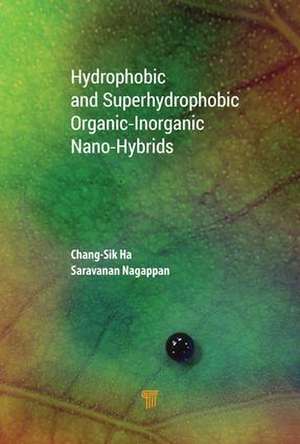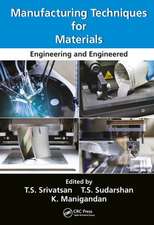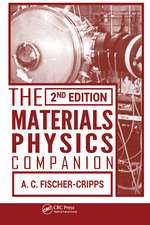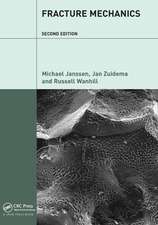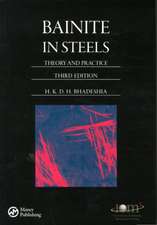Hydrophobic and Superhydrophobic Organic‐Inorganic Nano‐Hybrids
Autor Chang-Sik Ha, Saravanan Nagappanen Limba Engleză Hardback – 29 mar 2018
Preț: 836.72 lei
Preț vechi: 1020.40 lei
-18% Nou
Puncte Express: 1255
Preț estimativ în valută:
160.16€ • 174.02$ • 134.62£
160.16€ • 174.02$ • 134.62£
Carte tipărită la comandă
Livrare economică 21 aprilie-05 mai
Preluare comenzi: 021 569.72.76
Specificații
ISBN-13: 9789814774680
ISBN-10: 9814774685
Pagini: 190
Dimensiuni: 152 x 229 x 13 mm
Greutate: 0.46 kg
Ediția:1
Editura: Jenny Stanford Publishing
Colecția Jenny Stanford Publishing
ISBN-10: 9814774685
Pagini: 190
Dimensiuni: 152 x 229 x 13 mm
Greutate: 0.46 kg
Ediția:1
Editura: Jenny Stanford Publishing
Colecția Jenny Stanford Publishing
Public țintă
Academic and Professional Practice & DevelopmentCuprins
Hybrid Materials and Surfaces. Hydrophobic Organic–Inorganic Nanohybrids. Applications of Hydrophobic Organic–Inorganic Nanohybrids. Superhydrophobic Organic–Inorganic Nanohybrids. Applications of Superhydrophobic Organic–Inorganic Nanohybrids. Summary and Outlooks.
Notă biografică
Chang-Sik Ha is professor in the Department of Polymer Science and Engineering, Pusan National University (PNU), Korea, since 1982. He obtained his BS and MS in chemical engineering from the PNU and the Korea Advanced Institute of Science and Technology (KAIST), Daejeon, Korea, respectively, and his PhD in polymer physics from KAIST in 1987. He served as vice president of the PNU; president of the Society of Adhesion and Interfaces, Korea; and director of the Pioneer Research Center for Nanogrid Materials, National Research Foundation of Korea. He was elected to both the Korean Academy of Science and Technology (KAST) and the National Engineering Academy of Korea (NEAK) in 2004. He has also served as an editorial board member of several international journals.
Prof. Ha has received many awards, including the Samsung Polymer Science Award from the Polymer Society of Korea and the Scientist of the Month Award from the Ministry of Science and Technology, Korea, as well as an international award from the Society of Polymer Science, Japan. He has 72 patents to his name and has written 22 books and more than 700 articles in refereed journals. His research interests include materials for drug delivery systems, mesoporous materials and nanostructured materials, functional polymers, organic-inorganic nanohybrid materials, and bioinspired materials for superhydrophobic and superoleophobic coatings.
Saravanan Nagappan received his PhD in polymer science and engineer-ing from the PNU under the guidance of Prof. Chang-Sik Ha. He is now a postdoc fellow at the PNU and has been working on organic-inorganic nanohybrid materials and their applications, including hydrophobic and superhydrophobic coatings.
Prof. Ha has received many awards, including the Samsung Polymer Science Award from the Polymer Society of Korea and the Scientist of the Month Award from the Ministry of Science and Technology, Korea, as well as an international award from the Society of Polymer Science, Japan. He has 72 patents to his name and has written 22 books and more than 700 articles in refereed journals. His research interests include materials for drug delivery systems, mesoporous materials and nanostructured materials, functional polymers, organic-inorganic nanohybrid materials, and bioinspired materials for superhydrophobic and superoleophobic coatings.
Saravanan Nagappan received his PhD in polymer science and engineer-ing from the PNU under the guidance of Prof. Chang-Sik Ha. He is now a postdoc fellow at the PNU and has been working on organic-inorganic nanohybrid materials and their applications, including hydrophobic and superhydrophobic coatings.
Descriere
The book provides details of hydrophobic and superhydrophobic surfaces and discusses methods of fabrication of these surfaces based on the organic−inorganic nanohybrids. It covers recent applications of these surfaces, especially in environmental and energy applications. It is very useful in understanding the surface property of various materials and their potential applications and is a valuable guide for graduate students and scientists who have a background in chemistry, chemical engineering, material science and engineering, nanotechnology, surface science and engineering, and industrial coating application areas.
